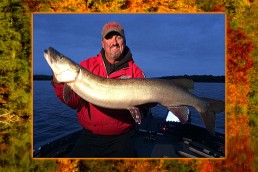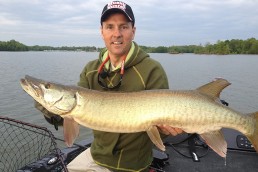Fall Muskie Crash Course
SHARE THIS POST
Weather, and its effect on muskie activity, almost works in reverse in the fall. While a warming trend with a ridge in place generally produces the best fishing throughout June, July and August, a consistent warmer pattern in the fall can often give fisherman a dud. Cold fronts with dominant high pressure behind them are the key.
Plummeting barometric pressure with a decrease in water temperature appears to be the big trigger. As the amount of daylight shortens more each day, muskies, as well as other fish and game, seem to sense the approach of winter and begin to feed anxiously before, during, and sometimes, after a strong cold front.
The location of muskies throughout fall varies greatly depending upon the water temperature, length of day and the body of water. This is why it is a mistake to categorize or generalize all muskie fishing in the fall as one single subject. The weather, water temperature and length of day in September are certainly different from that in November. Yet some anglers continue to refer to fall muskie fishing as “one period,” and mistakenly think you can fish for this species the same way from Labor Day until ice-up.
This simply isn’t true.
What works in September rarely works in October—and certainly isn’t going to get it done in November.
Muskies are apt to be shallower while water temperatures hold above the 50-degree range and are more apt to be weed-related. Remaining stands of healthy weeds can be hot spots, and they pinpoint shallow muskie locations. The odds of finding a trophy-class fish in any weed bed steadily increase as the mass of weeds depletes. However, weeds become far less productive once the water temperatures dip below 50. This is when steeper breaks and classic, hard, bottom structure really comes into play.
In fact, hard bottom substrates become the most consistent producer as the calendar creeps toward November and water temperatures dip into the 40s. Usually, rocks situated on steeper breaks are a key component. Hard bottom points with quick breaks into deep water can be particularly good. Add some submerged wood to this equation and it becomes even better.
Are you enjoying this post?
You can be among the first to get the latest info on where to go, what to use and how to use it!
Tactics in the fall depend a lot upon the exact time of the season and the depth muskies are holding at. Both in-line and safety pin-style spinners can be good for September and October muskies, but one absolute key in the presentation with any spinner in the fall is slow. For some odd reason, a muskie will chase down a fast-moving crankbait or an erratic-action jerkbait during the colder water periods, but has almost no interest in a spinner that moves fast. As soon as the fish move deeper, spinners of any kind seem to lose their appeal.
Erratic lures with hang-time really shine as the water cools down. Jerkbaits have a legendary reputation as fall muskie producers, and the sinking- or suspending-style glider bait is especially attractive as the water gets colder. There are many excellent models to choose from. Find one that fits your style and fish it hard over high-percentage hot spots. These really produce when muskies are still in relatively shallow castable range.
Personally, I end up relying heavily on deep divers the more the water cools, no matter whether I am trolling or casting. Crankbaits are always good no matter what the season, but they come into their own during October. They can be worked in a wider range of effective retrieve speeds and get closer to the deeper fish. Casting deep weed edges and bouncing hard-bottom ledges is particularly effective.
Motor-trolling cranks is a mainstay fall tactic throughout most of North America. These are incredibly effective for covering large, featureless flats as well as deep, open water. This is one of the key tactics used on Green Bay’s Great Lakes muskies. This style of trolling allows you to cover both featureless flats and deep, open water efficiently. Add modern GPS to the mix and you are able to reconnect with the “needle-in-the-haystack” fish fairly consistently.
Jigs and soft plastic swimbaits are now one of the hottest fall casting lures. In many instances, these lures have revolutionized the game of casting for deep-water muskies. Anglers all over the muskie world are now fishing exclusively with this lure style in the colder water when fish move deeper and become bottom-tight. These baits require a super-heavy action rod and strong shoulders, but the results are worth noting. While many anglers simply cast out these swimbaits and reel ‘em in, they can be worked effectively with a crank/stop-and-drop technique. Working it much like a bass swim jig is bound to catch coldwater muskies consistently.
Finally, you must gear up both physically and mentally once the calendar creeps toward November. Strong troughs from the north in mid- to late October and arctic-like elements in November in northern areas can become a major factor any time you attempt to chase muskies. You have to mentally and physically prepare yourself for your outings in the fall, including dressing appropriately and being prepared to battle potentially frigid elements any week. September’s 60-degree weather and shallow-feeding muskies may become a distant memory later in the fall. The subsequent weather conditions can be a grueling test of your grit. As mentioned above, slow, meticulous fishing in deep water is often the key, and a single strike this time of year yields high anticipation since the biggest muskies in the entire system are on the feed.
MWO
SHARE THIS POST
Did you enjoy this post?
You can be among the first to get the latest info on where to go, what to use and how to use it!
Joe Bucher
Joe Bucher is a Freshwater Fishing Hall of Fame Legendary Angler, book author, lure designer and host of Fishing with Joe Bucher TV series.



